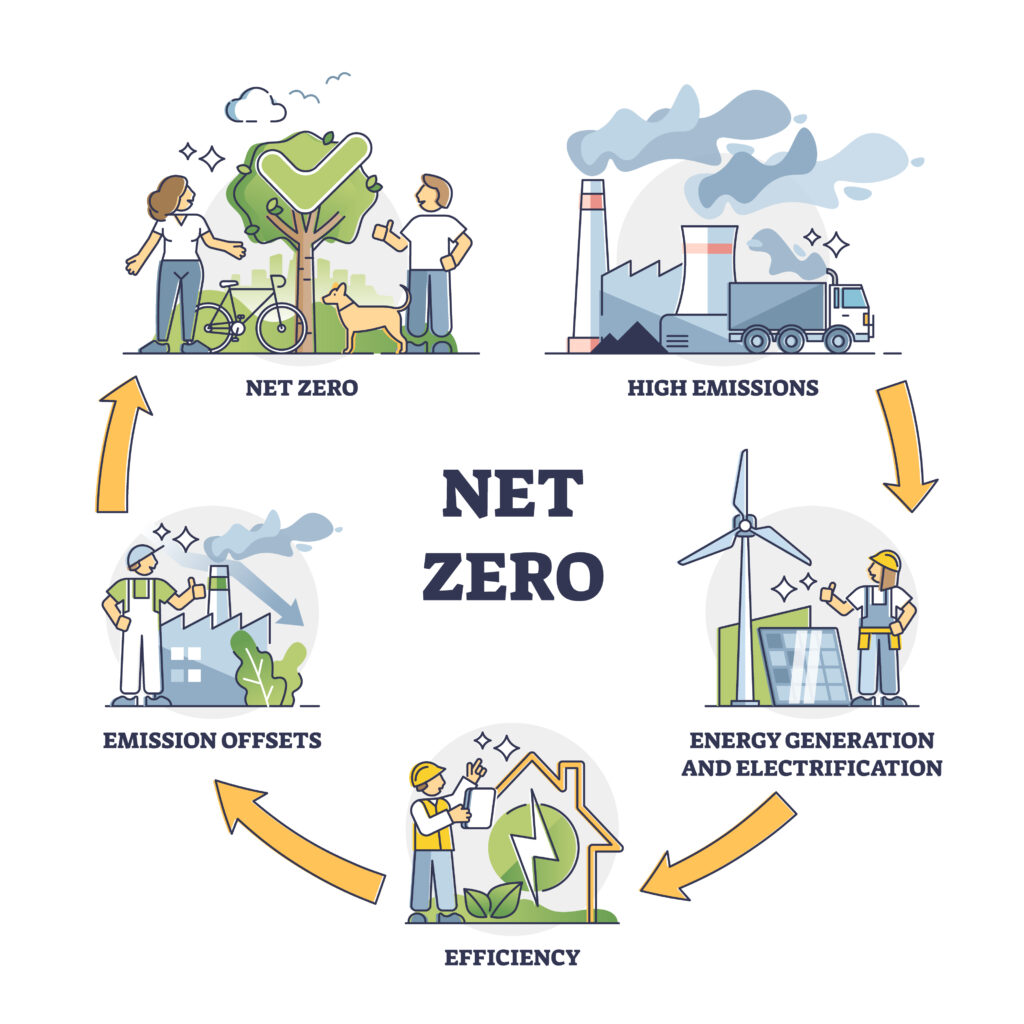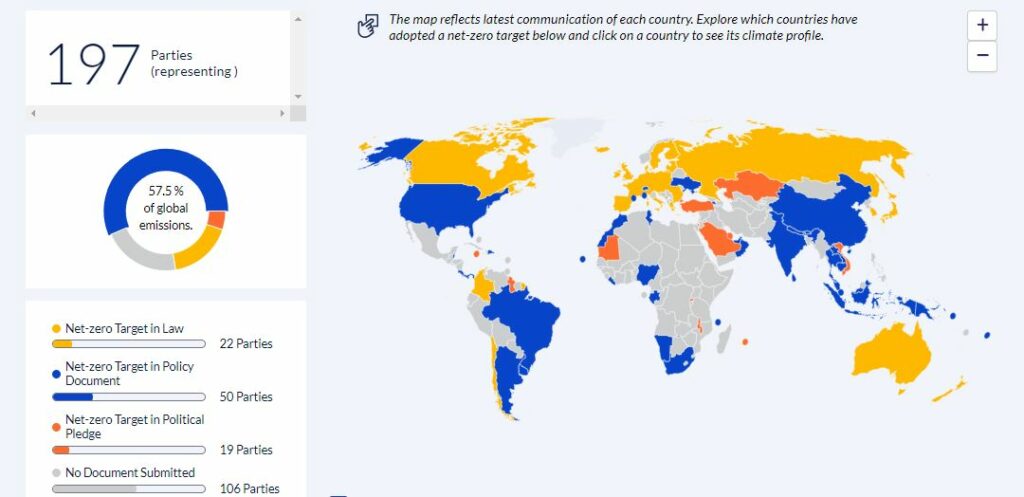What does it mean to be net-zero?
The idea of achieving net-zero carbon emissions originated from physical climate science, but its implementation involves social, political, and economic systems. Simply put, net-zero refers to the balance between greenhouse gas emissions and the removal of those gases from the atmosphere. This balance is also known as “carbon neutrality.”
To achieve net-zero, the carbon footprint must be reduced as much as possible. This involves decreasing energy consumption, reducing waste, and adopting sustainable practices. For the residual emissions that cannot be eliminated, different ways must be explored to offset them, such as by investing in carbon capture technology or supporting projects that remove carbon dioxide from the atmosphere, like reforestation.
All individuals, businesses, and governments have a role to play in achieving net-zero, and doing so not only benefits the environment but can also lead to practical and economic benefits. Many companies and organizations have made net-zero pledges or set net-zero targets for themselves. Financial institutions have also become increasingly interested in funding sustainable projects that contribute to net-zero goals.

Why is net-zero important?
Net-zero is a phrase that has been gaining a lot of attention lately and for good reason. It refers to the concept of achieving carbon neutrality, or in other words, eliminating the net amount of greenhouse gas emissions that are released into the atmosphere. This is crucial for the well-being of humans, animals, and the planet as a whole.
Firstly, the effects of climate change resulting from increasing levels of greenhouse gas emissions are already being felt around the world. From rising sea levels, extreme weather events, and heatwaves to loss of biodiversity and changes in ecosystems.
Secondly, transitioning to a net-zero economy provides business opportunities, new jobs, and improved economic performance. The renewable energy sector is booming and other industries are innovating to reduce their carbon footprint. Companies that prioritize sustainability are finding they are more attractive to younger and more environmentally conscious consumers. Governments can also use the transition to net-zero as an approach to boost investment and economic growth.
Finally, the success of achieving net-zero relies on international cooperation, giving us an avenue for global unity in addressing the most pressing issue of our time. Many governments and organizations around the world have made public pledges to reach net-zero by a certain date, thus increasing global pressure.
The Intergovernmental Panel on Climate Change released a report in 2018 that analyzed measures to limit temperature rise to 1.5°C. The report called for global efforts to achieve net-zero emissions of carbon dioxide by 2050. Achieving net-zero emissions requires a massive and concerted effort from all sectors, including the energy, transport, and agricultural industries. The Glasgow Climate Pact, signed at COP26 to commemorate the five-year anniversary of the Paris Agreement, highlighted the significance of establishing ambitious net-zero objectives.
How can net-zero be achieved?
Achieving net-zero is no small feat, but it is vital if we are to avoid the worst effects of climate change. The goal of net-zero is to reduce greenhouse gas emissions as much as possible and offset any remaining emissions through measures such as carbon capture or the planting of carbon sinks, such as forests. Here are some ways that net-zero can be achieved:
- Increasing renewable energy sources: This is perhaps the most obvious and essential way to achieve net-zero. The world must obtain as much of its energy from renewable sources, such as wind and solar power, as possible. Governments and companies alike must invest heavily in renewable energy infrastructure, such as wind farms and solar panel installations.
- Improving energy efficiency: Another way to reduce greenhouse gas emissions is by improving energy efficiency. This can be done by employing energy-saving measures, such as insulation and low-energy lighting, or by using more efficient appliances and machinery.
- Carbon capture and storage: This method involves capturing carbon dioxide emissions from power plants and industrial processes and storing them underground rather than releasing them into the atmosphere. While this technology is still relatively new, it shows great potential for reducing emissions.
- Direct air capture: This method involves using technology to remove carbon dioxide directly from the air. While it is still in its early stages, direct air capture could prove to be a valuable tool in achieving net-zero.
- Electrifying transportation: The transportation sector is a major contributor to greenhouse gas emissions. By electrifying transportation through the use of electric vehicles or public transport systems, emissions can be greatly reduced.
- Carbon offsetting: For any emissions that remain after all other measures have been taken, carbon offsetting can be used to balance out the overall impact. This can be done by investing in projects that remove carbon from the atmosphere, such as reforestation or the use of carbon capture and storage as discussed above.
In conclusion, achieving net-zero is a complex and challenging task, but it is one that must be undertaken if we are to avoid the worst effects of climate change. Achieving net-zero emissions will require significant effort from all stakeholders. By adopting multiple measures, we can work towards a world where emissions are greatly reduced and climate change is less of a threat.
Countries with Net-Zero Targets
As the urgency to tackle climate change increases, countries around the world are setting targets to reach net-zero greenhouse gas emissions. Net-zero emissions refer to the balance between the amount of greenhouse gases emitted and removed from the atmosphere.
The Paris Agreement, which was signed in 2015 by 196 countries, sought to limit global temperature rise to below 2°C above pre-industrial levels, with a goal to further limit it to 1.5°C. To achieve this crucial target, the Paris Agreement included a provision for countries to achieve net-zero emissions by the second half of this century.
Many countries have established or pledged to establish targets for achieving net-zero emissions that align with the temperature goals of the Paris Agreement. Several countries, including the UK, Germany, France, Spain, Norway, Denmark, Switzerland, Portugal, New Zealand, Chile, Costa Rica (2050), Sweden (2045), Iceland, Austria (2040) and Finland (2035), were among the earliest to commit. Both Bhutan, a small Himalayan Kingdom, and Suriname, the most forested country in the world, have achieved carbon-negative status by absorbing more CO2 than they emit.
According to a report by the Energy and Climate Intelligence Unit (ECIU), as of October 2021, a total of 140 countries, accounting for 75% of global greenhouse gas emissions, have set net-zero targets. These targets range from 2030 to 2070, with the majority aiming for 2050. Among these 140 countries, the European Union (EU) has set one of the most ambitious targets, aiming to reach net-zero emissions by 2050, with an intermediary goal of reducing emissions by at least 55% compared to 1990 levels by 2030. The United States has also joined the net-zero club, setting a target to reach net-zero emissions by 2050, with an intermediary goal of reducing emissions by 50-52% compared to 2005 levels by 2030.
Other large emitters, such as China and India, have also set goals to reach net-zero emissions, with China aiming for carbon neutrality by 2060 and India aiming for net-zero emissions by 2070. However, a few major emitters, such as Russia and Brazil, have yet to set net-zero targets.
The net-zero commitments made by these countries represent a positive shift towards climate action but more needs to be done to ensure that these targets are met. The Net-Zero Tracker by Climate Watch outlines the methods used to establish targets, including nationally determined contributions (NDCs), long-term strategies, domestic laws, policies, or pledges from heads of state or other cabinet members.
Image: Net-zero Tracker by Climate Watch
Countries need to implement policies and measures to reduce emissions across all sectors, from energy production to transportation, and invest in technologies for carbon capture and storage. Moreover, international cooperation and partnerships are vital to achieving global net-zero emissions.
It is important to note that setting targets and meeting them are two different things, and countries need to take concrete steps to achieve their goals. Nevertheless, the increasing number of countries setting net-zero targets demonstrates a global commitment to tackling the climate crisis and a promising start toward a more sustainable future.
Is the World on Track to Reach Net-Zero Emissions on Time?
As the effects of climate change become increasingly visible and devastating, there is a growing urgency to reduce global greenhouse gas emissions to net-zero as soon as possible. Net-zero emissions mean that any carbon dioxide released into the atmosphere is balanced out by removing the same amount, or more, from the atmosphere. This is a critical step in limiting global temperature rise and preventing the worst impacts of climate change.
The Paris Agreement set a target of limiting global temperature rise to well below 2°C above pre-industrial levels and pursuing efforts to limit it to 1.5°C. It requires reaching net-zero emissions by mid-century or soon after. However, despite growing awareness and ambition, current global emissions trajectories are not on track to reach net-zero emissions by mid-century. The International Energy Agency (IEA) estimates that even if all countries meet their current emissions reduction pledges for 2030, it will not be enough to limit global temperature rise to 1.5°C. Instead, it would lead to a temperature increase of around 2.1°C.
This gap between current trajectories and the Paris Agreement’s goals highlights the need for stronger and more ambitious climate action. The IEA recommends several measures to achieve net-zero emissions by 2050, including rapid scaling up of renewable energy, increased energy efficiency, significant electrification of transport and buildings, and development of carbon capture and storage technology.
Financial institutions and the private sector also have a critical role to play in driving the transition to net-zero. They can support the development and deployment of low-carbon technologies, provide financing for climate-friendly projects, and integrate climate risk into investment decision-making.
Additionally, countries need to regularly review and strengthen their climate policies and commitments, setting interim targets and increasing ambition over time. They can also work together to share knowledge and technology, invest in climate adaptation measures, and support developing countries in their transition to low-carbon economies.
In conclusion, while the world is not currently on track to reach net-zero emissions by mid-century, there is still time to turn this around. Urgent action is needed to accelerate the transition to a low-carbon economy and limit global temperature rise to 1.5°C. Governments, businesses, and individuals must work together to take bold and ambitious climate action before it’s too late.
Read similar topics:
